#Italian folklore
Explore tagged Tumblr posts
Text
Cow man AU
so I was looking that the Werewolf Peppino AU and I thought: "I like this idea!.... I wonder if there is an 'italian werewolf' or something"
Turns out, there is an Italian Werewolf, A "Were-Ox" to be exact...

Introducing: Muliache Peppino
According to the ancient legends of Sardinia (an Italian island) : The Muliache and The Erchitu are men who turn into a Were-Ox during the full moon, they have large horns covered in metal and two lit candles on the ends.

The key difference is that The Ertichu is a punishment for a horrible crime, usually killing someone, On the other hand, The Muliache is a curse and the person is innocent, and Peppino has the curse one.
The mark of his curse looks like the marking of a Branding iron, while human, it looks like a faded scar that becomes more clear as the full moon comes closer

As for Peppino, is best for him to keep calm and don't resist to the transformation for, if he does that, it hurts.
Also Pepstavo angst I had to, and goddammit I forgot the mark in this drawing
I might draw more about Muliache Peppino, If you guys want to draw him be my guest.
'Kay see ya'
Buh-Bye! :)
#pizza tower#pizza tower au#art#peppino spaghetti#pizza tower peppino#gustavo#pepstavo#Muliache#Ertichu#Muliache AU#Poor Peppino can't catch a break :(#pizza tower gustavo#doodle#digital art#italian folklore#italian folk magic#Italian legends#Muliache Peppino#Cursed Tower AU
69 notes
·
View notes
Text
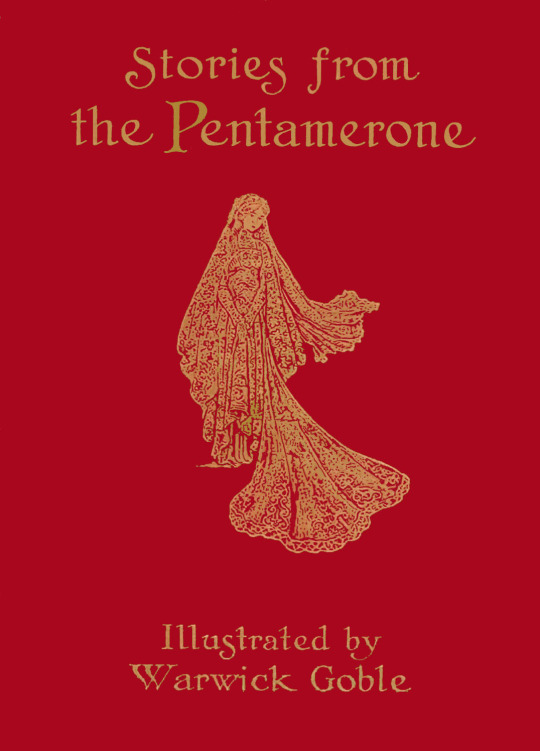
STORIES FROM THE PENTAMERONE by Giambattista Basile (1575-1632) (New York/London: Macmillan, 1911). Translated by John Edward Taylor (1847). Dozens of illustrations by Warwick Goble.

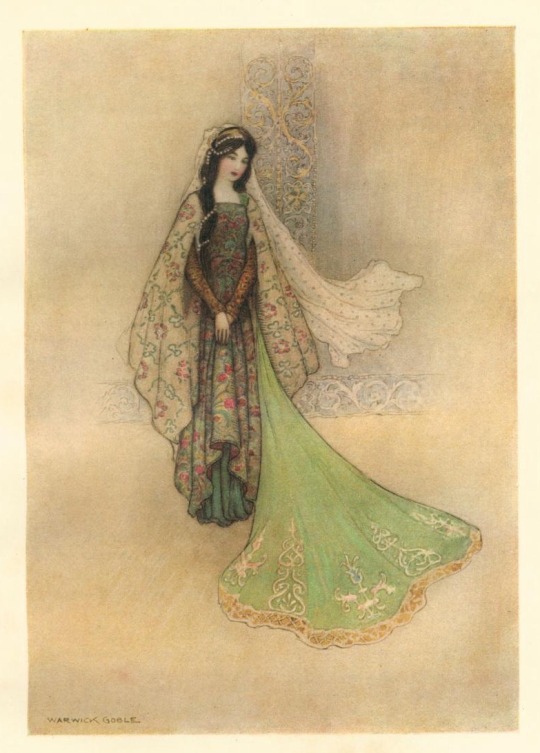
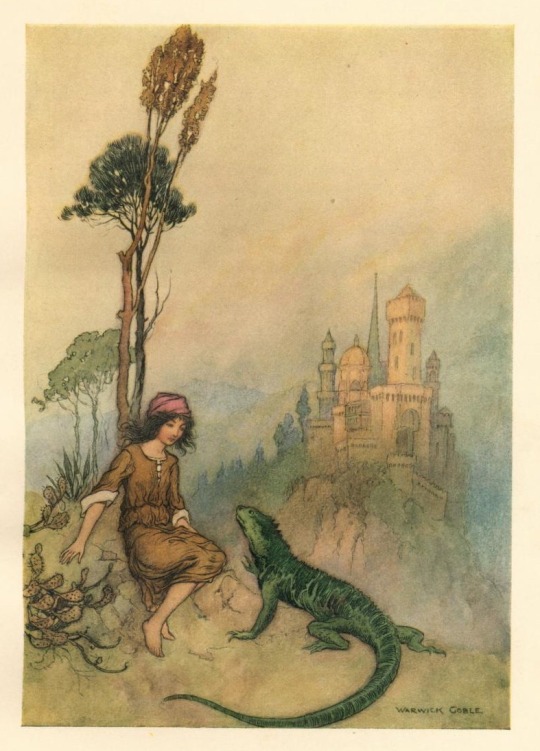
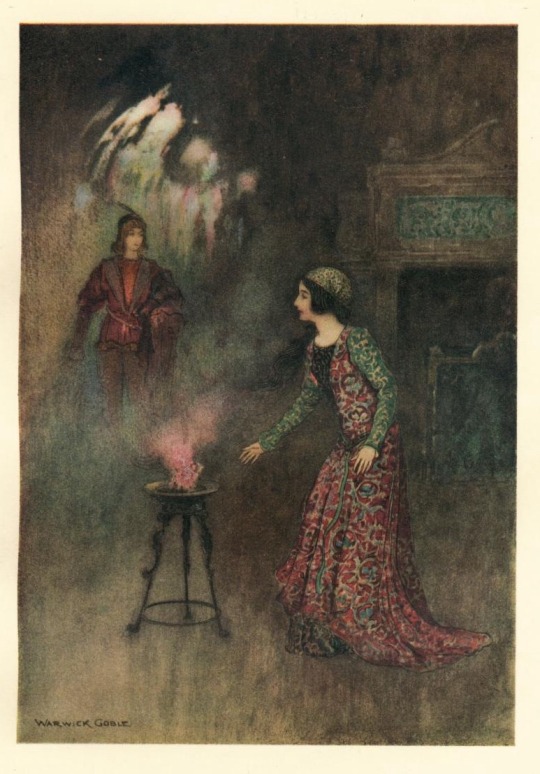
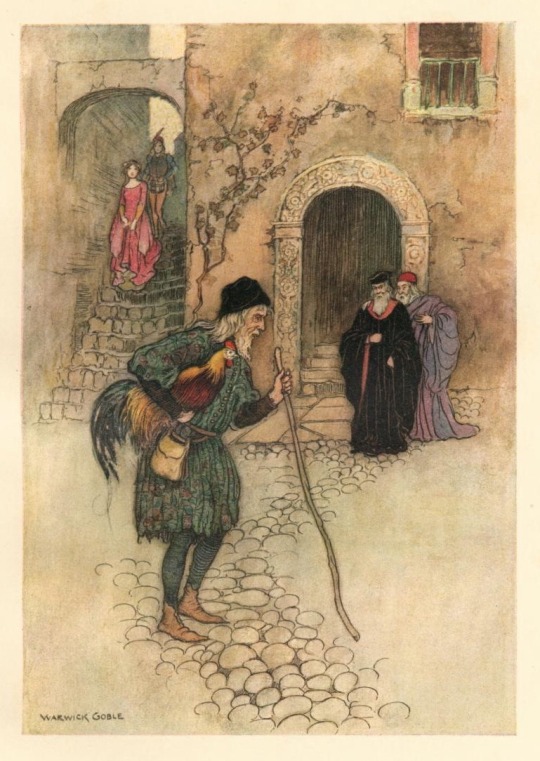
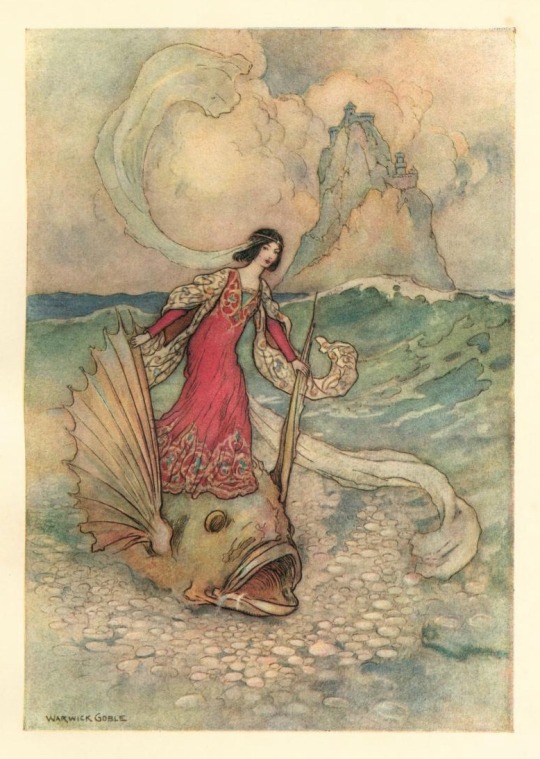
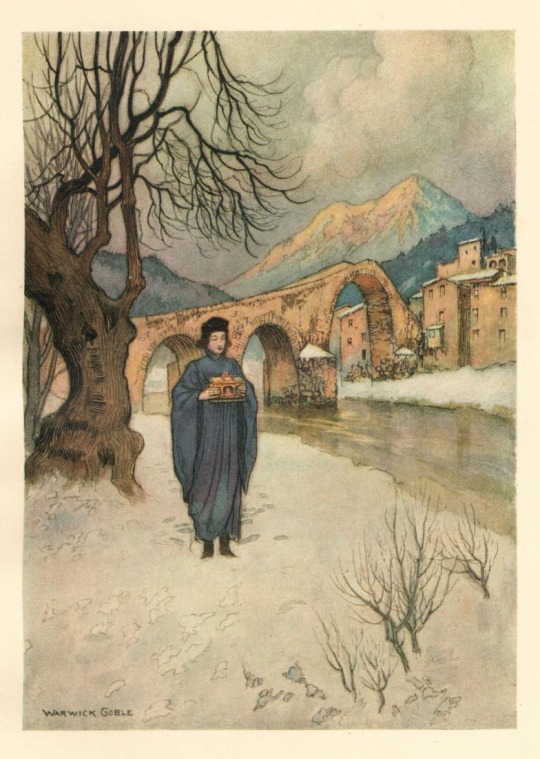
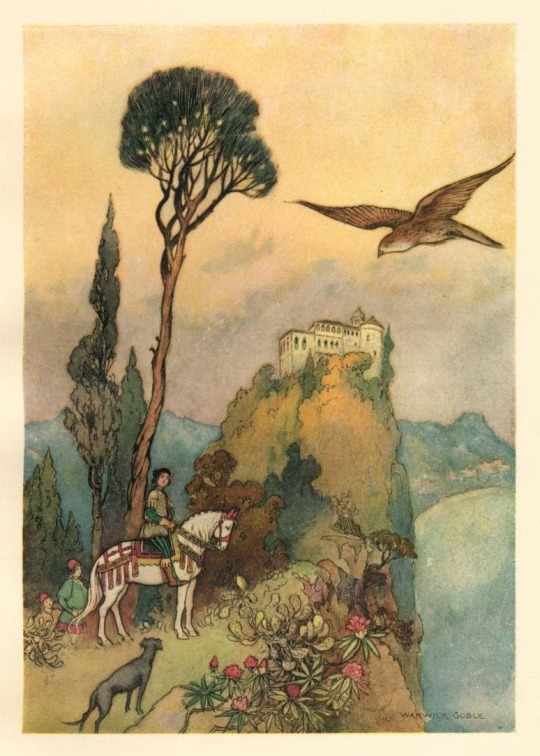
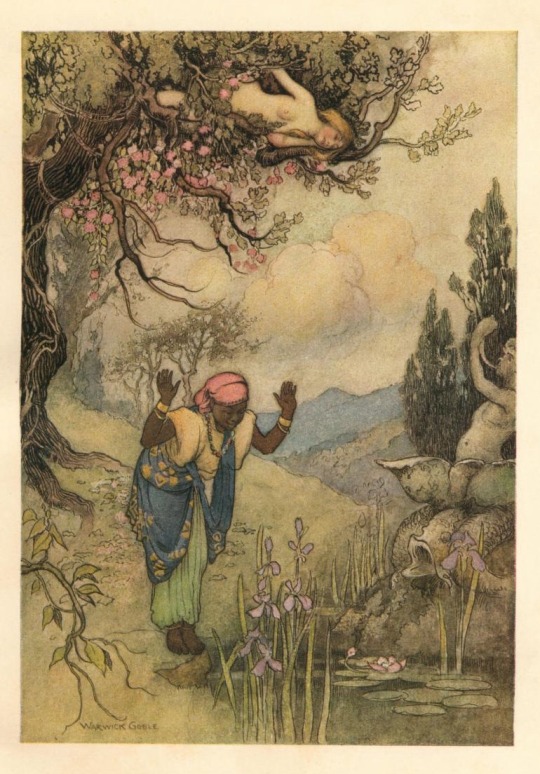
source
#beautiful books#book blog#books books books#book cover#books#vintage books#illustrated book#children’s book#book design#warwick goble#folk tales#italian folklore
66 notes
·
View notes
Text
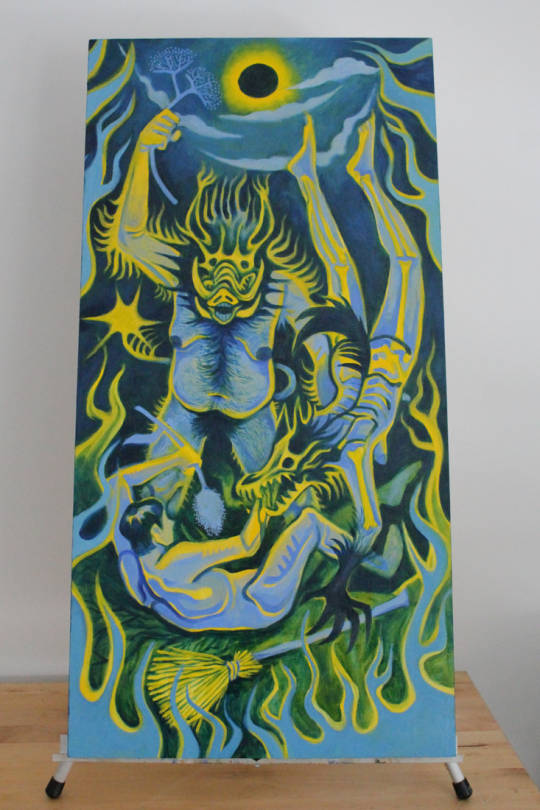
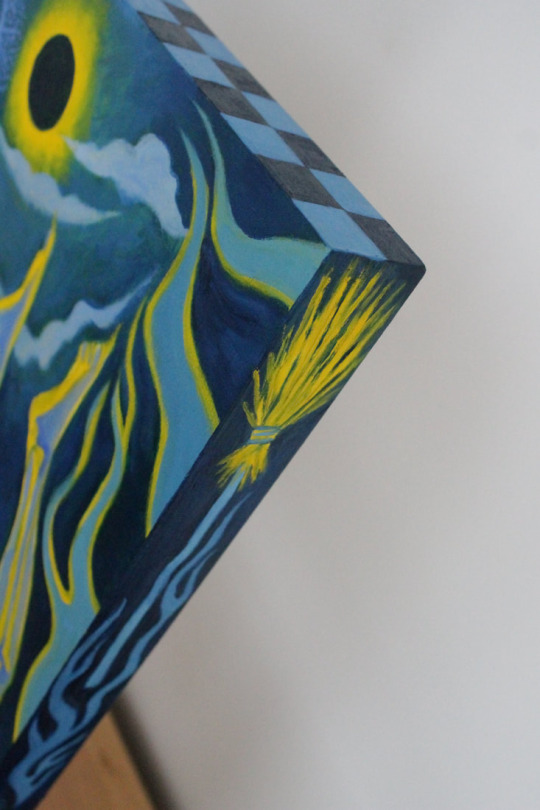
i thought i had posted the final painting here but i had not!
unfortunately i only have quite blurry pictures right now but i may update this post in the future when i receive the piece back from the gallery.
the night battle, 30"x15", oil on cradled panel, made for a gallery show themed around the occult
“The Night Battle” depicts the Friulian benandanti, the “Good Walkers”, benevolent witches that travel out of their bodies at night to battle against the malevolent malandanti, in the hopes of bringing about good crops. The benandanti occasionally took the form of animals, and occasionally overlap with werewolf stories. I primarily connect with my Italian ancestry through folklore, and the stories that were passed down from my family were stories with a cisheteronormative, Roman Catholic lens. In response I wanted to make a piece in defiance to those stories where queer and trans bodies may bring about a bountiful future harvest.
121 notes
·
View notes
Text

La Befana: an Epiphany tradition in Italy
The Epiphany is a Christian festival celebrating the arrival of Jesus Christ into the world, the moment when the three Wise Men came to Jerusalem from Asia, Europe and Africa to worship the incarnation of God. For Western denominations, it is celebrated on 6 January, exactly 12 days after 25 December, Christmas Day. The etymology of the Epiphany is to be found in ancient Greek, used to indicate a divine manifestation or apparition.
The pagan meaning of Epiphany, however, is linked to propitiatory rites for agriculture between the 10th and 6th centuries B.C. and, between ancient Rome and the Middle Ages, to Roman winter solstice celebrations that continued for 12 days after 25 December, with each day representing one of the 12 months of the year.
In Italian folklore, the Befana is an old woman or witch who delivers gifts to children throughout Italy on Epiphany Eve (the night of January 5) in a similar way to Santa Claus or the Three Magi Kings.

In popular folklore, the Befana visits all the children of Italy on the eve of the Feast of the Epiphany to fill their socks with candy and presents if they are good, or a lump of coal or dark candy if they are bad. In many poorer parts of Italy and in particular rural Sicily, a stick in a stocking was placed instead of coal.
She is usually portrayed as a hag riding a broomstick through the air wearing a black shawl and is covered in soot because she enters the children's houses through the chimney.
Photo taken in Motta Filocastro (Calabria, Italy) by @mimmolarox
Follow us on Instagram, @calabria_mediterranea
#befana#epiphany#calabria#italy#italia#south italy#southern italy#folklore#italian folklore#hag#witch#italian#traditions#tradition#europe#6 january#mediterranean
105 notes
·
View notes
Text
Working With Aradia

Queen of Witches
Origin: Italian folklore, daughter of Lucifer and Diana
Other titles: Bringer of Magick, Freer of Slaves, Queen of Faeries, Holy Strega
Colors: Black, white, silver, gold, green, red
Herbs: Anise, belladonna, lemon, jasmine, rue, vervain
Crystals: Moonstone, pearl, opal, labradorite, goldstone
Dates: August 13th, Friday the 13th
Day: Friday
Animals: Cats, foxes, snakes, deer
Domains: Witchcraft, divination, justice, equality, witches and practioners of magick, the enslaved, outcasts, the lost, freedom
Offerings: Incense, flowers (especially those that bloom at night), milk, honey, wine, cakes, anything associated with the moon, songs, poems, and invocations
Symbols: Moons, suns, pentacles, wands, chalices, swords, stars
"I am the daughter of the Sun and Moon and even though I have been born into this world, my race is of the stars." - The Charge of Aradia
#satanic witch#satanism#withcraft#demons#magick#witch#demonolatry#lefthandpath#dark#witchcraft#eclectic witch#italian witchcraft#italian folklore#Aradia#Goddess
27 notes
·
View notes
Text
Folk Witch Tip #1
Just to be sure, double cleanse your place spiritually. just like we double cleanse our face at night or double wash our hair. I’m not talking about complex cleansing rituals, just pouring table salt on liminal spaces and saying a prayer while vacuuming is more than enough.
#witchblr#witchcraft#witch community#witch#witches of tumblr#witches#folk magic#folk witch#folk spellcraft#italian folk magic#folk witchcraft#folk christianity#folk catholicism#italian folklore#folklore#witch tips#traditional witchcraft#budget witchcraft#witchy tips
135 notes
·
View notes
Text

Little magical horses, the caddos birdes are not much larger than the island's local sheep. Could one such horse truly be worth the havoc required to claim ownership?
#BriefBestiary#bestiary#digital art#fantasy#folklore#legend#myth#mythology#sardinian folklore#sardinian legend#italian folklore#italian legend#caddu birde#caddos birdes#magical horses#monteleone rocca doria
17 notes
·
View notes
Note
What are your thoughts on "The Young Slave" from The Pentamerone?
Ah, the same way I feel about most stories from the Pentamerone: very grateful that we still have it, as a part of fairy tale history, without exactly liking it.
The Pentamerone (by Giambattista Basile, published posthumously in 1634/1636) is an incredibly important collection, but the tales are rather brutal. "The Young Slave" is no different. Basile's collection of Neapolitan fairy tales contains the oldest known literary version of many very well-known fairy tales. In the case of "The Young Slave" the story of Snow White. While it also contains elements that are more well-known for showing up in different fairy tales. For example:
��� The beautiful protagonist, Lisa, was born because her mother swallowed a rose petal. This motif shows up in various Spanish, Portugese and Scandinavian folktales.
• Lisa is blessed by two fairies and cursed by a third to die prematurely, similar to Sleeping Beauty. (Though the fairy is not an unwanted guest, or inherently evil, she speaks in anger because she twists her ankle.)
• Because of the curse Lisa gets a comb stuck in her hair, which poisons her, and is put in seven crystal coffins and hidden away. While there is no evil queen, this does have similarities with Snow White.
• Lisa's mother firbids her brother, the baron, to open the room with the coffin and dies. Years later his wife discovers the coffin, however, and Lisa has by then aged into a beautiful young woman. The jealous woman drags her out by her hair, knocking the comb loose and waking her up. This reminds me more of Gold Tree and Silver Tree which is itself often named as a Snow White variant.
• Lisa's jealous aunt now takes the role of evil stepmother, dresses and treats her as a slave and abuses her. Much like various versions of Snow White.
• One day the baron goes to a country fair and asks everyone his household what thing they would like him to bring for them, even the slave girl, despite his wife's anger. Lisa asks for a doll, a knife, and some pumice-stone, and adds that if he forgets to bring them, he will not be able to cross the river. This reminds me of some versions of Beauty and the Beast and Russian tales like Finist the Falcon, where a merchant father brings the youngest daughter an inexpensive but very significant gift.
• Lisa can make the doll talk to her by threatening self harm and tells it her sad life story. (I mostly know magical dolls from Slavic and Chinese fairy tales, but that might be lack of further reading on my part). The baron overhears her talking and realises what his wife has done. The motif of telling your misfortune to an object and being overheard shows up in tales like the Goose Girl, The Ghoulish Schoolmaster and the Stone of Pity, and more notably The Maiden with the Rose on her Forehead (which is likely a more direct descendant of The Young Slave than Snow White is.)
• The baron sends Lisa to relatives to recover and then invites her back home for a splendid banquet, where she tells everyone how she was treated by the baroness. The baron banishes his wife (which is surprisingly merciful) and finds a worthy husband for Lisa whom she loves. This big reveal at a banquet shows up in various stories, like true bride/forsaken fiancée stories, or variations on The Cruel Sister.
To me the most interesting element of this story, apart from it's very different beginning, is that Lisa's uncle is so instrumental, while her future husband is only mentioned in the very last line. In most folktales with an abusive wife, the husband is notably bad at doing anyting about her cruelty. So this makes a nice change!
#I have the Pentamerone#I have not once been able to read it all the way through#the young slave#italian folklore#laura babbles
26 notes
·
View notes
Text








“Il segno di Virgilio”, Roberto De Simone (1982)
Happy almost Ides of October, especially for my Italian and Italophone Classics nerds and Virgil stans, have some snapshots of the weirdest book I own.
Roberto De Simone is a folklorist, musicologist and writer from Naples, probably best known as one of the founding members of the Nuova Compagnia di Canto Popolare and a central figure in the Italian folk music revival of the 1970s-80s. He also wrote this magnificently strange tome on the legend of Virgil as a magical or divine figure and how he has thoroughly syncretized with Neapolitan folklore and folk religion in particular.
He puts Virgil himself in context as a poet, scholar and quite possibly esoteric mystic of his time, but the bulk of the book is about how he became a legendary folk “saint” - associated with everything from Hellenic and Italic sun gods to the Blessed Virgin - first in pre-Christian times and then being deliberately Christianized along with everything else sacred. He also collects a vast number of Neapolitan legends and folk tales featuring him in his various mystical and magical guises.
It’s also bound like a giant Renaissance grimoire full of engravings and illustrations and fancy typesetting. I would run into a burning house to save this thing.
It’s a bold and strange book, and I don’t know how well it would stand up to peer review, but it’s not meant to be a PhD thesis - it’s meant to be a book of magic and legend, with Maro’s radiant spirit hiding beneath the ink on every page.
#virgil#publius vergilius maro#Roberto de Simone#Neapolitan folklore#Italian folklore#Italian books#italic polytheism#folk catholicism
16 notes
·
View notes
Text
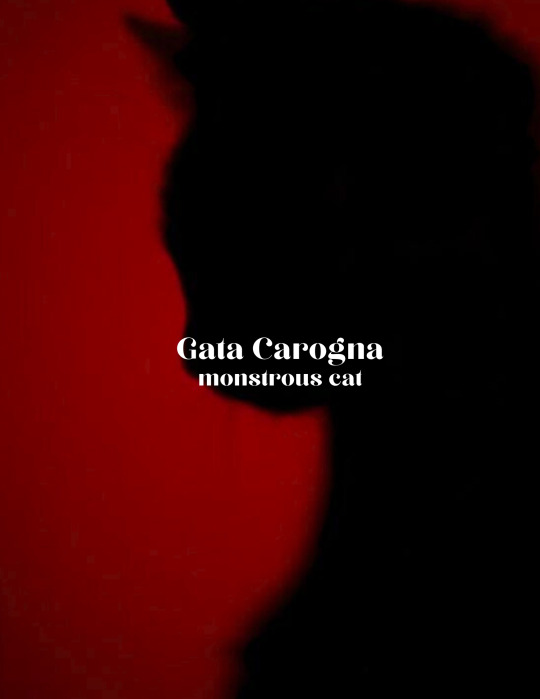
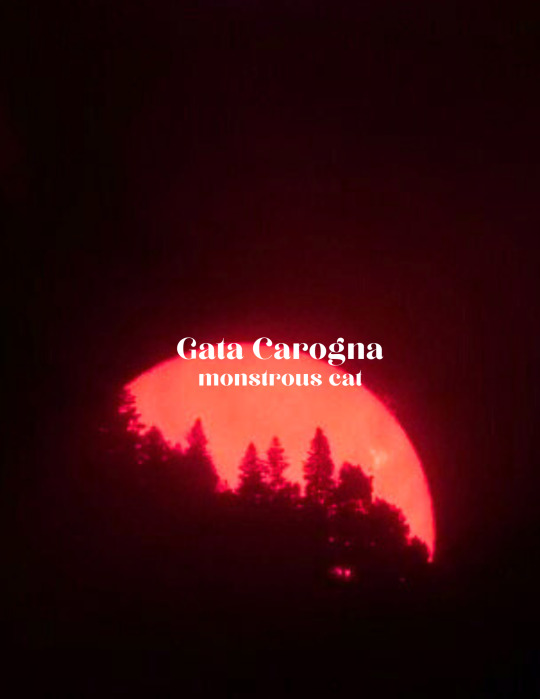
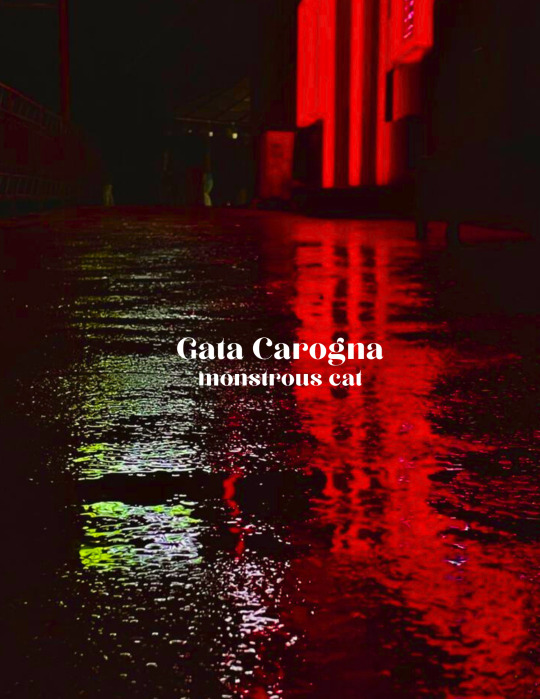
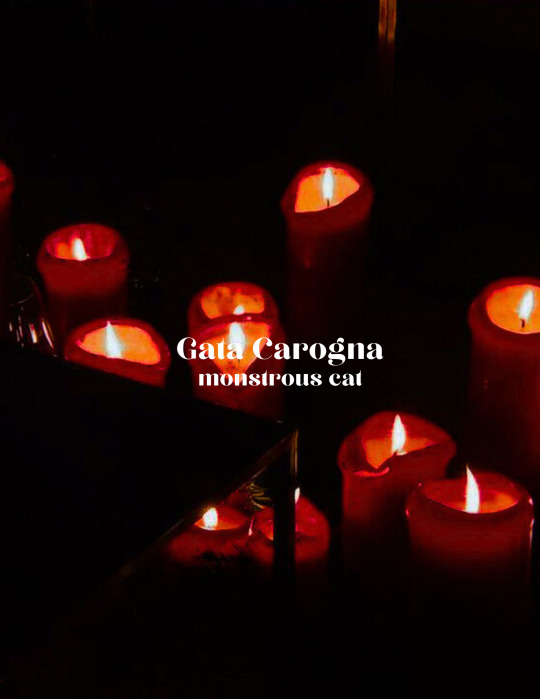
day 21 of horror mythology: gata carogna
in the folklore of lombardy, the gata carogna is a monstrous animal analogous to the mammone cat, which infests the dark alleys of the cities. she looks like a big red cat, with shaggy fur and angry eyes, who attack children to steal their souls.
75 notes
·
View notes
Text
baby witch here! im open to any tips & links / books that might be helpful !! also pls lets be friends
#witchcraft#witch community#witchblr#witches#magick#italian folk magic#italian folklore#streghe#stregoneria#hellenic polytheism#hellenic pagan#hellenic deities#paganism#paganblr#pagan witch#pagan
18 notes
·
View notes
Text
Italian folk magic basics
Italian witchcraft, also known as Stregoneria, is a form of traditional witchcraft that has its roots in ancient Italy. Here are some basics of Italian witchcraft:
The practice of Italian witchcraft is often passed down through family traditions, and many practitioners are born into it.
The practice involves working with spirits, ancestors, and deities, and often involves honoring the elements of earth, air, fire, and water.
Italian witchcraft is centered around the idea of "la vita e bella" (life is beautiful), and emphasizes the importance of finding joy and beauty in everyday life.
The use of natural materials, such as herbs, stones, and crystals, is an important part of Italian witchcraft. These materials are often used in spells and rituals, and are believed to have specific properties and energies.
The practice of divination, or seeking guidance from the spiritual realm, is also an important part of Italian witchcraft. This may involve reading tarot cards, using pendulums, or other methods.
The Italian witchcraft tradition places a strong emphasis on the importance of the sacred feminine, and many practitioners honor goddesses such as Diana, Hecate, and Isis.
Some Italian witchcraft traditions also incorporate elements of Catholicism, and may involve working with saints or angels as well as other spiritual beings.
Overall, Italian witchcraft is a deeply rooted and rich tradition that emphasizes connection with nature, spirit, and the sacred feminine. It is a beautiful and powerful practice that continues to inspire and captivate practitioners around the world.
#italian witchcraft#italian magic#italian magick#italian folklore#italian folk magic#book of shadows#grimoire#generational witchcraft#generational magic#witchblr#witchcraft
159 notes
·
View notes
Text
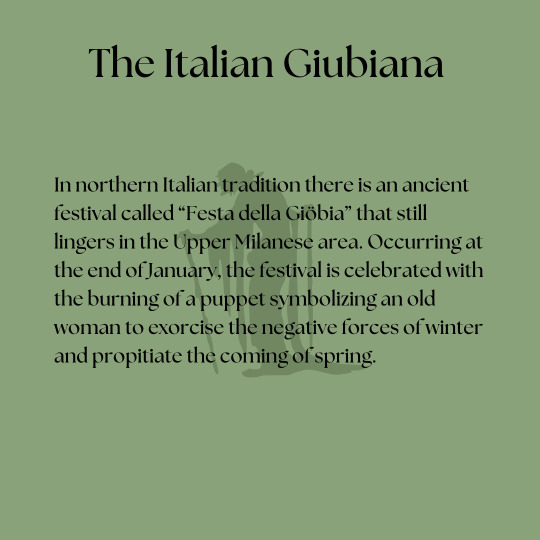
According to the folktale, the Giubiana was an old witch, thin, with very long legs and red stockings. She lived in the woods and because of her long legs, she never set foot on the ground, but moved from tree to tree. On the last Thursday of January, she used to go in search of some children to eat. One mother, to protect her child, decided to set a trap for her. She prepared a large pot full of yellow (saffron) risotto with luganega (sausage) and put it on the windowsill. The Giubiana attracted by the smell, came out of the woods, and began to eat all the contents of the huge pot. The risotto was so good that the ravenous Giubiana did not notice the time passing. She did not notice that the sun, which kills witches, was now about to rise. By the time the Giubiana finished all the risotto, the first ray of sunshine had come out: the Giubiana was thus pulverized by the sunlight, and from that day all the children were saved. To remember that event at the end of January, risotto with luganega is prepared and the puppet in the guise of the old witch is burned.
The name "Giubiana" seems related to the Roman god Jupiter, but other possible reference figures are Juno, Janus, and Diana.
In the medieval centuries the popular narrative created a variety of legends and numerous folk tales, in which Giubiana thus became a female figure alluding to the Great Mother, sometimes an old woman, sometimes a witch, a variant of the Befana, to be symbolically driven away along with the rigors of winter. The most distinguishing element of the festival is the great bonfire, which even today is perceived by all as a symbol of renewal and a new year's restart.
#witchcraft#witchblr#italianwitch#italian folklore#strega#giubiana#italian traditions#paganism#witches of tumblr#winter spirit#italian witchcraft#pagan witch#great godess#old witch#bonfire#renewal#italian tales#northern italy
45 notes
·
View notes
Text
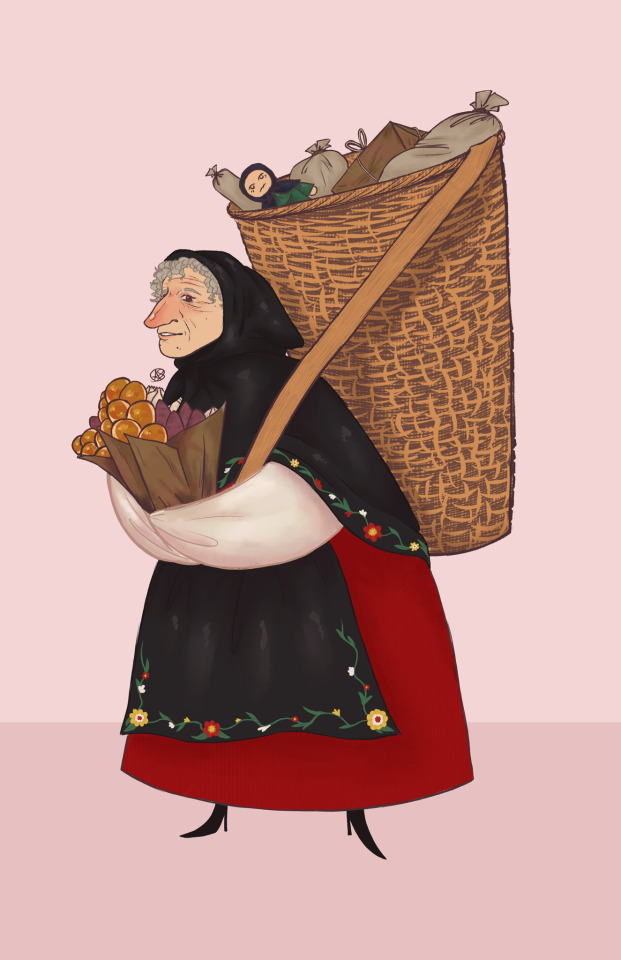

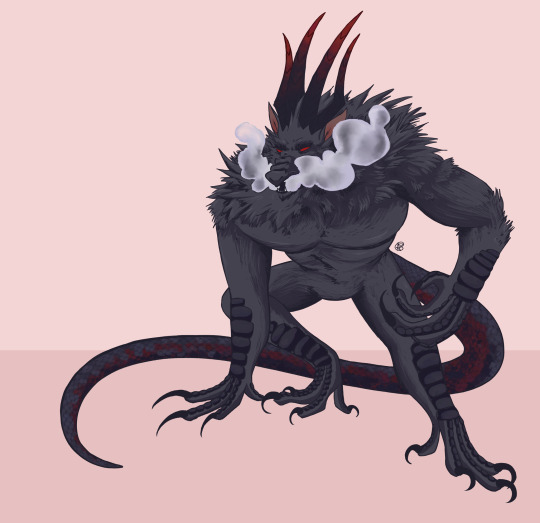
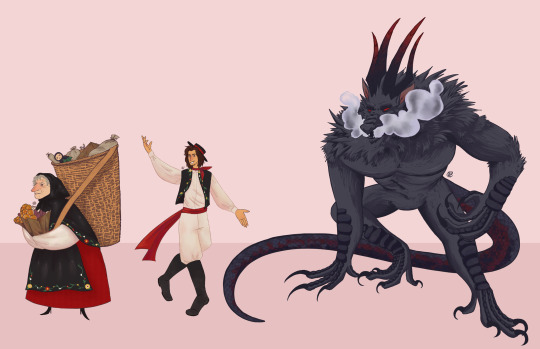
Sharing my final for my character design class! We had to create three designs based on one culture, and I chose Italy! Here’s La Befana, a villager folk dancer, and the demon Aamon.
51 notes
·
View notes
Text

My contribution for @zinemachine01 ;
I giorni della merla.
A once white bird outsmarted January’s tricks by hiding, but turned black after seeking refuge in a chimney during the extra cold days January borrowed from February.
#zine#digital#art#digital art#blackbird#red#fire#winter#January#february#folklore#tales#italian folklore#Italy
9 notes
·
View notes
Text
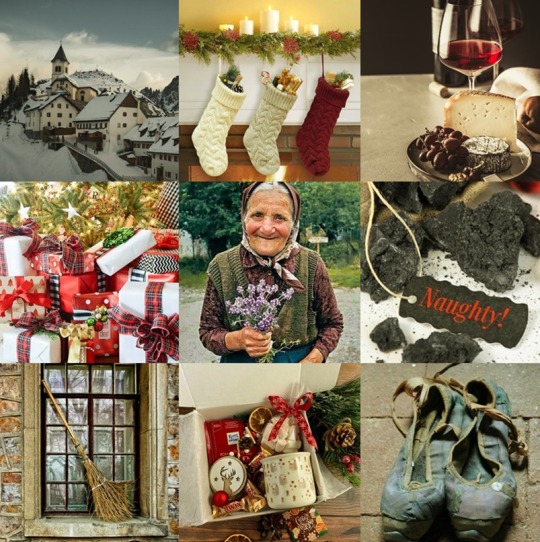
Befana Aesthetic
In Italian folklore, the Befana is an old woman or witch who delivers gifts to children throughout Italy on Epiphany Eve (the night of January 5) in a similar way to Santa Claus or the Three Magi Kings. In popular folklore, the Befana visits all the children of Italy on the eve of the Feast of the Epiphany to fill their socks with candy and presents if they are good, or a lump of coal or dark candy if they are bad. Being a good housekeeper, many say she will sweep the floor before she leaves. To some the sweeping means the sweeping away of the problems of the year. The child's family typically leaves a small glass of wine and a plate with a few morsels of food, often regional or local, for the Befana. She is usually portrayed as a hag riding a broomstick through the air wearing a black shawl and is covered in soot because she enters the children's houses through the chimney. She is often smiling and carries a bag or hamper filled with candy, gifts, or both.
Merry Christmas to all of you, happy holidays if you don't celebrate Christmas.
18 notes
·
View notes